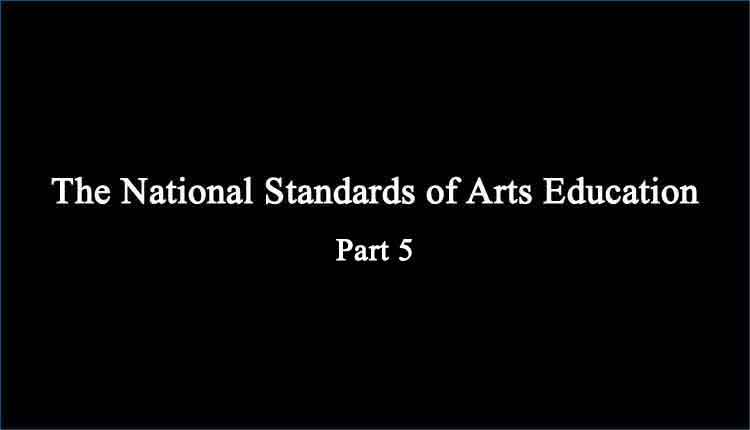The Fifth Standard, reading and notating music, is a crucial skill yet one that is fundamental to instrumentalists. Because of the way instrumental music classes are designed, the focus on reading music notation is more intensive in bands and orchestras than it is in general music classes or even in choirs but, as most teachers have come to expect, the requirements for Standard Five extend far beyond being able to read music and write notes on a page. Students are expected to recognize and understand standard notation, time and key signatures, rhythms, clefs, dynamics, tempi, and articulations. Sight-reading is another large component of this Standard, as are rhythmic exercises; advanced students are even expected to demonstrate an understanding of transposition.
The expectations for junior high students seem quite basic, but it is crucial that directors create this solid musical foundation at an early age, or they will likely fail to meet this Standard in high school. When it comes to reading and notating music, without detailed instruction and continued monitoring of their progress, it is easy for students to slip through the cracks. My sister recently admitted that she didn’t really learn how to read music until she got to high school; she was able to play well enough by ear that no one questioned her music reading ability. Many people I have spoken with over the years have made the same admission; they enjoyed being part of the band, but never really understood how to decipher all the notes and symbols in their music and because they were able to get away with sitting at the end of the section and pretending to follow along, they never took the time to learn.
By the time music students pass the eighth grade, they should be able to read note values from whole notes to sixteenth notes, (including dotted rhythms) and the corresponding rests. They should also be able to play music in simple meters, including 3/4, 6/8, and cut time. Other standard notation symbols, such as sharps and flats, dynamics, basic tempo markings, and articulations need to be recognizable as well, and students should be able to define these symbols and explain how they are used. The ability to name notes on a staff, in bass and treble clef, including a ledger line or two, is also expected, regardless of the range of a student’s instrument.
There are several ways to teach rhythm and gauge student understanding of notation. Rhythmic or aural dictation is an excellent way to get students to really listen and count. Challenge students to guess the meter of a song simply by listening to it, or play a rhythm for the class and ask students to write the corresponding note values and rests (if applicable). Another option is for the class to determine the rhythm of a familiar song together, writing all suggestions on the board, eventually coming to a consensus on which rhythm is most accurate. Many bands now include rhythm exercises in their daily warm-up routine, and singing, clapping, or playing a variety of different rhythms without worrying about other aspects of music such as pitch or intonation strengthens the connection between rhythms and the corresponding note values better than most other methods.
Although learning and performing scales was covered in Standard Two, the need for this skill resurfaces in the sight-reading component of Standard Five. Explain to students that knowing how to identify key, meter, decipher tricky rhythms, and take note of any additional accidentals is key to playing a piece of music at sight. It is also helpful to understand interval relations (half and whole steps) between scale degrees and connecting these to the corresponding pitches on their instruments. Depending on age and ability level, students are expected to sight read, with accuracy and expression, music with a difficulty level of grade two to grade four.
Advanced high school students should be able to read an instrumental or a vocal score, starting with a score that has anywhere from two to four staves and eventually moving onto to a full score. This includes reading notes in all clefs, understanding and explaining how to find the concert pitch for all transposing instruments, and describing how musical elements are used in the score. Some may even want to dabble in non-standard notation, deciphering the symbols created and used in contemporary compositions.
Although musicianship is comprised of several different elements, music notation is one of the building blocks of the discipline. It is nearly impossible to do well in a literature course without knowing how to read; musicians who do not know how to read and write in the language of music are just as illiterate. Because notation is not as subjective as some of the more creative aspects of music, nearly every student should be able to learn how to read music at a similar pace. The playing field will likely be more level than it is for improvisation or composition, where some students may discover they have a “knack” for the activity while others may struggle; some may never fully understand. Some students will undoubtedly catch on faster than others, but with thorough training and diligent reinforcement, every student should eventually be able to read and notate music.
Parts of this article were taken from National Standards for Arts Education. Copyright 1994 by Music Educators National Conference (MENC). Used by permission. The complete National Arts Standards and additional materials relating to the Standards are available from MENC — The National Association for Music Education, 1806 Robert Fulton Drive, Reston, VA 20191.
Read National Standards Introduction >>
Read National Standards Part 1 >>
Read National Standards Part 2 >>
Read National Standards Part 3 >>
Read National Standards Part 4 >>
Read National Standards Part 5 >>
Read National Standards Part 6 >>
Read National Standards Part 7 >>
Read National Standards Part 8 >>
Read National Standards Part 9 >>


